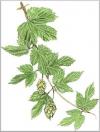Common hop - Humulus lupulus
A liana-like climber reaching six metres in height, with slightly woody stems which twine round other plants (e.g. Hawthorn, Sloe) in spirals, always in a clock-wise direction. The stems are covered with tiny hooked thorns so they can attach themselves firmly to bushes. The leaves are palmate and toothed, divided into three (sometimes five) deep lobes; the stalks and veins are prickly. The Hop is dioecious, i.e. the male and female inflorescences develop on different plants. The male flowers are in the form of small cobs whilst the female flowers are protected by large bracts which turn paper-like when the fruits ripen. The plant flowers from June to September. In the wild, it lives in damp woods and hedgerows all over Italy; it is common in the North and in the Apennines, but rare in Mediterranean areas and on the islands. Since the 1600's it has been extensively grown in northern and central Europe to flavour, preserve and lighten beer. In fact, the bitter taste of this popular drink comes from substances in the female flowers. In spring, the tender young shoots (known locally as "lòppori") are still gathered to make omelettes with or to eat like asparagus tips.




